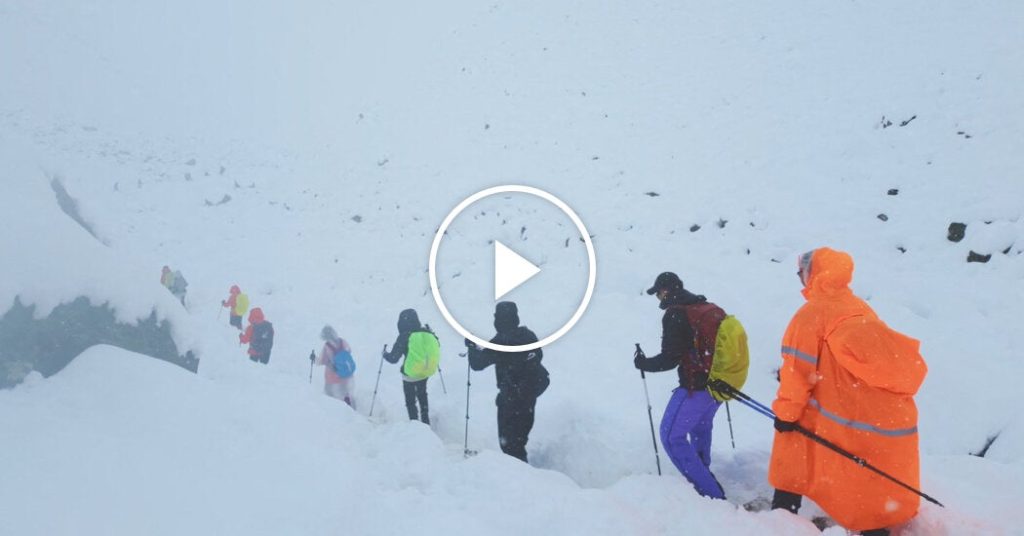Everest Emergency: Hundreds of Hikers Stranded in Sudden Snowstorm
Mountain Crisis Unfolds as Visibility Plummets on World’s Highest Peak
By James Harrison | Special Correspondent
October 6, 2025
A dangerous situation has unfolded on the slopes of Mount Everest, where hundreds of hikers have been stranded following an unexpected and severe snowstorm that drastically reduced visibility across the mountain’s challenging terrain. The sudden weather event has triggered an emergency response from local authorities and rescue teams who are now working against deteriorating conditions to reach those affected.
The snowfall began early yesterday morning, quickly intensifying beyond seasonal norms and catching many climbing groups off-guard despite the regular monitoring of weather patterns that is standard practice for Everest expeditions. “The storm developed with unusual speed,” explained Dr. Mingma Sherpa, a veteran mountaineering guide and weather specialist with the Nepal Mountaineering Association. “Within hours, visibility dropped to less than ten meters in some areas, making navigation extremely hazardous even for experienced climbers familiar with the mountain.”
Rescue Operations Underway Amid Challenging Conditions
According to the Tibetan Mountaineering Association, approximately 340 climbers and support staff are currently stranded at various points along the northern routes of the mountain. Most are gathered at established camps between 18,000 and 21,000 feet (5,500 to 6,400 meters), where supplies and shelter provide temporary safety. “We’ve initiated emergency protocols and are coordinating with Chinese authorities to deploy helicopter rescue teams where possible,” said Tashi Tsering, head of emergency response for the region. “However, the continuing snowfall and high winds are severely restricting air operations above certain altitudes.”
Communication with the stranded groups remains intermittent, primarily relying on satellite phones and radio systems that function sporadically in the harsh conditions. Reports from several expedition leaders indicate that while most climbers are in stable condition, concerns about supplies and deteriorating weather are mounting. “Our immediate priority is maintaining shelter integrity and conserving resources,” radioed Alex Donnelly, an expedition leader with Summit Expeditions, from Camp 3. “We’re rationing oxygen and food, but if this storm continues beyond 48 hours, the situation will become increasingly precarious.”
Climate Concerns and Increasing Risks on Everest
This emergency highlights the growing concerns about changing weather patterns on Everest, where traditional climbing seasons are becoming less predictable. Climate scientists have documented significant changes in the Himalayan region over the past decade, with more frequent extreme weather events occurring outside the expected parameters. “What we’re seeing is consistent with climate models that predict greater instability in high-altitude weather systems,” explained Dr. Elizabeth Chang, climatologist with the International Mountain Research Institute. “The warming of the Tibetan plateau is affecting air circulation patterns around Everest, potentially making traditional climbing windows less reliable.”
The current situation also raises questions about the increasing number of climbers attempting Everest each year. The 2025 autumn climbing season had seen a record number of permits issued, with over 600 climbers registered to attempt the summit from both the Nepalese and Tibetan sides of the mountain. “The commercialization of Everest has resulted in larger crowds on the mountain, which complicates both regular climbing operations and emergency responses,” noted Tenzing Norgay, grandson of the famous first summiteer and an advocate for more sustainable mountaineering practices. “When emergencies like this occur, the sheer number of people needing assistance can overwhelm available resources.”
International Response and Coordination Efforts
The emergency has prompted an international response, with mountaineering organizations from multiple countries offering assistance. The Alpine Rescue Coordination Center in Switzerland has activated its satellite monitoring system to provide real-time weather data to rescue teams, while the International Mountain Guides Association has put specialized high-altitude rescue teams on standby. “This is a multinational effort requiring precise coordination,” said Jean-Pierre Bouvier, director of the Alpine Rescue Coordination Center. “We’re sharing resources and expertise across borders to ensure the best possible outcome for everyone stranded on the mountain.”
Chinese authorities have established an emergency command center in Tingri, the nearest substantial settlement to the northern base camp, where medical teams and supplies are being assembled. Meanwhile, specialized Sherpa rescue teams with extensive high-altitude experience are preparing to ascend from lower camps once conditions permit. “The Sherpa rescue teams are the backbone of any Everest emergency response,” acknowledged Liu Wei, spokesperson for the Chinese Mountaineering Association. “Their knowledge of the mountain and ability to operate in extreme conditions will be crucial in the coming days.”
The Human Story: Climbers and Families Wait for Resolution
Behind the logistics and emergency operations are the human stories of those directly affected by the crisis. Families of stranded climbers have gathered at information centers in Kathmandu and Lhasa, anxiously awaiting updates. “My daughter has been training for Everest for three years,” said Michael Ramirez, whose 29-year-old daughter Sofia is among those stranded. “She’s experienced and well-prepared, but as a parent, you never stop worrying. The waiting and limited information are excruciating.”
For the climbers themselves, the unexpected emergency has transformed an adventure into a test of survival skills and mental resilience. Many expeditions include climbers who have invested years of preparation and significant financial resources to attempt Everest. “There’s a powerful human element to these situations that often gets overlooked,” observed Dr. Sarah Westcott, a psychologist specializing in extreme environments. “Being stranded in one of Earth’s most hostile environments creates intense psychological pressure. How people respond to that stress can be as important as their physical preparation.”
As rescue operations continue and weather forecasters predict the storm may begin to abate within the next 36 hours, the mountaineering community remains focused on bringing everyone down safely. This emergency serves as a stark reminder of the unforgiving nature of high-altitude environments and the increasing unpredictability that climbers must now factor into their expeditions in our changing climate. For those stranded on the mountain and their loved ones awaiting news, the coming days will require patience, resilience, and the hope that the storm breaks before supplies run critically low.











